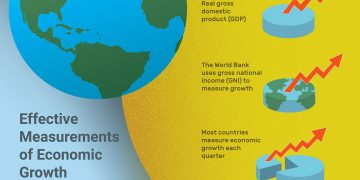The United States is the world’s largest economy and one of the most influential players in the global financial system. As such, any significant shifts in the U.S. economy, particularly regarding its fiscal health and government debt, can have far-reaching consequences. In recent years, the rising U.S. government debt has become a pressing issue, sparking debates on its long-term sustainability and the potential risks it poses to both the U.S. and the global economy.
The U.S. national debt has been climbing for decades, but in recent years, especially following the COVID-19 pandemic and the associated fiscal stimulus measures, it has reached unprecedented levels. As of 2025, the U.S. national debt has surpassed $30 trillion, with annual deficits continuing to increase. This raises the critical question: Could the U.S. government debt crisis trigger a chain reaction that impacts the global economy?
In this article, we will explore the potential consequences of a U.S. government debt crisis, examine the interconnectedness of the global economy, and assess whether a crisis in U.S. debt would indeed have a cascading effect on economies around the world.
1. Understanding the U.S. Government Debt Crisis
The U.S. government debt refers to the total amount of money the federal government owes to creditors. This debt can be broken down into two main categories:
- Public Debt: This is the portion of the debt owed to external creditors, such as foreign governments, international investors, and institutions. It accounts for a significant share of the total U.S. debt and is influenced by the U.S.’s fiscal policies, trade balances, and the broader global demand for U.S. Treasury bonds.
- Intragovernmental Debt: This refers to the debt the U.S. government owes to itself, particularly through trust funds like Social Security and Medicare.
The debt crisis could be triggered if the U.S. government faces a situation where it is unable to meet its debt obligations due to rising interest payments, fiscal mismanagement, or an inability to raise new debt. This could result in a default on government bonds or a downgrade of the U.S. credit rating, both of which would have severe consequences for both the U.S. economy and the global financial system.
2. Why Is U.S. Debt Growing?
There are several reasons behind the rapid increase in U.S. government debt in recent years:
2.1. Fiscal Stimulus and COVID-19 Response
The COVID-19 pandemic triggered an unprecedented fiscal response from the U.S. government. The government passed multiple stimulus packages to support businesses, individuals, and the healthcare sector, leading to a sharp increase in spending and borrowing. While these measures helped the U.S. economy avoid a deeper recession, they also led to a significant rise in the national debt.
2.2. Rising Entitlement Spending
U.S. government spending is heavily concentrated in mandatory programs, particularly Social Security, Medicare, and Medicaid. As the population ages, the costs of these entitlement programs are expected to grow significantly, putting additional pressure on government finances. In the absence of reforms to address these costs, the debt is projected to continue growing.
2.3. Military and Defense Spending
The U.S. has one of the largest defense budgets in the world. While military spending is crucial for national security, it also constitutes a significant portion of federal expenditures. The costs associated with maintaining a global military presence and responding to various geopolitical crises have contributed to the growing debt.
2.4. Tax Cuts and Budget Deficits
In recent years, the U.S. has implemented significant tax cuts, which have reduced government revenue. While proponents of these cuts argue that they stimulate economic growth, the resulting budget deficits have further contributed to the growing national debt. Without a corresponding reduction in government spending, these tax cuts exacerbate the debt problem.
3. The Potential Consequences of a U.S. Debt Crisis
If the U.S. were to experience a government debt crisis, the impact would be felt not only domestically but globally. The U.S. economy is deeply interconnected with the rest of the world, and many foreign governments and investors hold U.S. debt. The ripple effects of a debt crisis could lead to a series of cascading economic consequences. Let’s explore some of these potential impacts:
3.1. Global Financial Market Turmoil
The U.S. Treasury market is the largest and most liquid bond market in the world. U.S. Treasury bonds are considered one of the safest investments, and they serve as a benchmark for interest rates globally. If the U.S. were to default on its debt or experience a credit downgrade, it would send shockwaves through global financial markets.
- Rising Borrowing Costs: A downgrade of the U.S. credit rating would increase borrowing costs for the U.S. government, as investors would demand higher yields on U.S. bonds to compensate for increased risk. This could have a ripple effect on global interest rates, leading to higher borrowing costs for governments, corporations, and individuals around the world.
- Stock Market Volatility: A U.S. debt crisis could trigger widespread panic in global stock markets. Investors could move away from riskier assets, leading to sharp declines in equity prices. This would create significant volatility, affecting not just the U.S. but other major stock markets around the world.
- Flight to Safety: In times of crisis, investors typically flock to safe-haven assets like gold and the U.S. dollar. However, a crisis involving U.S. debt could undermine the global trust in U.S. Treasury securities and the U.S. dollar, causing a shift in capital flows to other safe-haven assets, such as the euro or the Japanese yen.
3.2. Currency Instability and the U.S. Dollar’s Decline
The U.S. dollar is the world’s primary reserve currency, and it is used in international trade, investment, and as a store of value by central banks around the world. A U.S. government debt crisis could undermine confidence in the dollar, leading to its depreciation relative to other currencies.
- Global Trade Disruptions: A weaker dollar could make U.S. exports cheaper, which may provide some relief to U.S. manufacturers. However, it could also increase the cost of imports, leading to higher inflation in the U.S. and disrupting global trade flows.
- Loss of Reserve Currency Status: If the U.S. were to default on its debt or face a severe fiscal crisis, countries around the world might begin to diversify away from the dollar in their foreign reserves. This could lead to a shift toward other currencies, such as the euro or the Chinese yuan, as reserve currencies. Such a move would have significant consequences for global financial stability and the U.S. economy.

3.3. Impact on Emerging Markets
Many emerging market countries hold large amounts of U.S. dollar-denominated debt, and a U.S. debt crisis could exacerbate their financial difficulties. These countries often rely on U.S. dollar borrowing to finance their own infrastructure and development projects.
- Debt Default Risks: A weaker dollar and higher global interest rates could make it more difficult for emerging markets to service their debt. This could lead to a wave of debt defaults, particularly in countries that have large amounts of foreign-currency debt.
- Capital Flight: A crisis in U.S. government debt could trigger capital outflows from emerging markets, as investors seek to reduce their exposure to risk. This could lead to currency devaluations, higher inflation, and economic instability in these countries.
3.4. Global Recession Risk
A U.S. government debt crisis could trigger a global economic downturn. The U.S. is the world’s largest consumer and one of the biggest drivers of global economic growth. A debt crisis could lead to a reduction in U.S. consumption, investment, and economic activity, which would have a knock-on effect on other economies around the world.
- Trade Slowdown: A slowdown in the U.S. economy would reduce demand for imports, which could negatively impact export-dependent countries, especially those in Asia and Europe.
- Global Financial Stress: As global financial markets react to the U.S. debt crisis, credit conditions could tighten worldwide, making it harder for businesses and governments to access financing. This could lead to lower investment and reduced economic growth globally.
4. What Can Be Done to Prevent a U.S. Debt Crisis?
To avoid a debt crisis and its associated global repercussions, the U.S. must take steps to address its fiscal imbalances. This includes:
- Debt Reduction Measures: The U.S. government needs to implement a sustainable fiscal policy that reduces budget deficits over time. This could include reforms to entitlement programs, changes to tax policy, and cuts to discretionary spending.
- Debt Ceiling Negotiations: Regular negotiations over the debt ceiling need to be resolved more efficiently, as the inability to raise the debt ceiling can trigger crises of confidence in the markets.
- Bipartisan Fiscal Cooperation: A more cooperative approach to fiscal policy across political parties is necessary to ensure long-term economic stability. This includes creating balanced budgets, reducing reliance on borrowing, and implementing policies to foster economic growth.
5. Conclusion: The Global Economic Implications of a U.S. Debt Crisis
The U.S. government debt crisis is not just a domestic issue—it has the potential to trigger a chain reaction that impacts the global economy. The interconnectedness of financial markets, the reliance on the U.S. dollar as a reserve currency, and the extensive global trade links mean that a U.S. debt crisis could lead to financial instability, currency volatility, and economic recessions around the world.
While a U.S. debt crisis is not inevitable, the risks of continuing on the current fiscal path are significant. By addressing fiscal imbalances and pursuing sustainable policies, the U.S. can mitigate the risk of a debt crisis and prevent a global economic catastrophe. However, the clock is ticking, and timely action is necessary to avoid the potentially severe consequences of a government debt crisis.



































